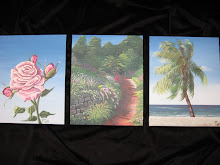If you want a tougher and finer finish, a base paint that is primarily a flat mid-sheen oil-based paint would help you achieve that remarkably well as it is non-absorbent, therefore the colored glaze would slide on easily, and won't sink in. Apply the glaze using a white brush 100 or 125mm [4 or 5inch] in width and generously bristled. Dragging on the other hand only needs a cheap standard brush 100mm [4inches] in width. However, use white spirit [mineral spirits] for thinning the glaze. Glycerin, from a chemist or druggist, may help to keep an emulsion wash malleable for a longer period.
Dragging works best with two people, one applying the glaze or wash, and the other one dragging it off; and while doing this the state of mind you should aim for is attentive but relaxed. Bristles should touch the wall firmly but lightly. Use rags to wipe dragging brush every couple of strokes or so to prevent it from becoming loaded with glaze ... you don't want to put color on instead of dragging it off! Allow transparent oil glaze a day or two to dry. Thinned paint dries faster although it doesn't produce quite the same crisp finish as transparent oil glaze. But it's easier to handle. Complete dragged wall with coat of clear matt or colorless acrylic varnish as a protection against wear and tear or washing down.
A comb is another tool that can create a magnificent dragging effect on a wall with relative ease. You can actually make your own comb by simply cutting a plastic lid in half, and then cutting V-shaped notches about ¼-inch long into the straight edge of a cut lid. Depending on the look you want to create, spacing between notches can be even or uneven, but to avoid excess paint buildup between notches, make teeth fairly narrow.
In both techniques, you work your way down the wall with brush (or the comb) from top to bottom... and some professionals even add side to side, then top to bottom again over the same strip. I'd say experiment with different ideas when applying these two techniques -- you never know what you will discover. Have fun with it!
Dragging is a faux-painting technique that produces thin, vertical stripes on the wall. It works best on wood paneling or a smooth wall surface. A dry brush or a comb can be used to create this look of luxury, but it does work best with two people, one applying the glaze or wash, and the other one dragging it off. So the next time you want to spruce up your walls with special paint finishes, consider dragging.
About Author:
Anthony J. Namata is a successful Internet Marketer and author of How to Become An International Gemstone Dealer and his popular online journal Diary Of An Internet Marketer
Shop for your favorite products and name brands AND help the world become a better place...Find out more at: http://www.maxmalls.com/
Article Source: http://EzineArticles.com/?expert=Anthony_J._Namata
 WallDreams Paint Ideas! Dragging has several aliases including strie, combing, and sometimes basketweave, stripping and wood graining. Also included are many of the "fabric" techniques like linen, denim, grasscloth, burlap, and canvas.
WallDreams Paint Ideas! Dragging has several aliases including strie, combing, and sometimes basketweave, stripping and wood graining. Also included are many of the "fabric" techniques like linen, denim, grasscloth, burlap, and canvas. Dragging can be combined with other techniques to create interesting feature points in a room. Try alternating vertical stripes with a glaze combed through some of the stripes. Or harlequin diamonds with alternating diamonds having a glaze dragged within.
A great tool to use for dragging are wallpaper brushes because they are 12 inches wide and window squeegees too! Another option is a surfacing broom.
To keep the lines from going off-kilter, tape off plumb lines about 36 to 42 inch sections around the room and work every other section pulling off the tape as you go. Let the sections dry then go back and fill in the unpainted sections.
Til next time, keep those brushes clean!
Donna of WallDreams














No comments:
Post a Comment